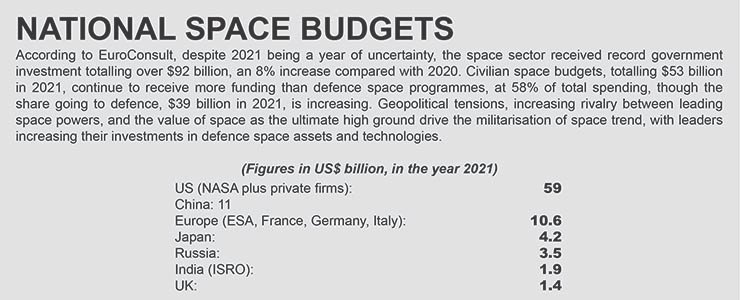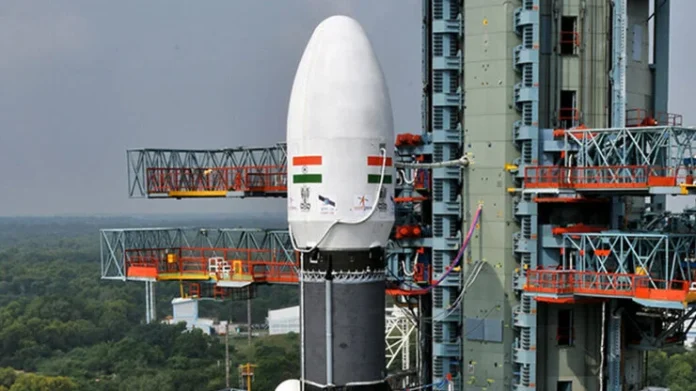Sometime in 2024, the Gaganyaan mission will launch a three-member Indian crew into low-earth orbit, making India the fourth nation (after Russia, the US and China) to acquire human spaceflight capability. The Indian Space Research Organisation’s 629-ton GSLV Mark III heavy-lift rocket will carry the three vyomanauts who will spend a total of seven days in space.
Gaganyaan will be the culmination of India’s achievements – both civilian and military – in space. Over the past decade, India’s demonstrated space capacities include missions to the Moon and Mars; Earth observation; navigation; anti-satellite (ASAT) weapons; and the ability to launch more than a hundred satellites on a single rocket. Future plans include the Aditya mission to study the Sun; the Chandrayaan-3 lunar mission; Mangalyaan-2 to return to Mars; and Venus in the mid-2020s. According to Mylswamy Annadurai, the scientist behind the successful Mars and Moon missions, “our long-term mission will be to have a permanent research station on the moon”.
Explore or Perish
After decades of being the world’s most low-profile space agency, ISRO is preparing for a high-octane push into space. Space exploration is important because nations that establish bases and colonies in space and near-Earth objects will gain a huge advantage. A quick glance at history shows that during the colonial era – roughly the 15th to 19th centuries – the European nations launched sea voyages to explore the planet. Pirates such as Francis Drake of England were backed by the rulers of their countries to find new land, gold and slaves for “god and country”.
The nations of Western Europe despatched — or rather expelled — their surplus and unwanted populations into the newly ‘discovered’ territories of North and South America, Africa and Oceania, eventually claiming entire continents in the name of their king, queen or Pope.
The parallels to colonialism are hardly far-fetched. The late Neil Armstrong, who was the first man on the moon, wrote about the need for Americans to return to earth’s only satellite: “Some question why Americans should return to the moon. After all, they say, ‘we have already been there’. I find that mystifying. It would be as if 16th-century monarchs proclaimed that ‘we need not go to the New World, we have already been there’. Americans have visited and examined six locations on Luna, varying in size from a suburban lot to a small township. That leaves more than 14 million square miles yet to explore.”
Many Americans share Armstrong’s colonising zeal. As a US expert declared after the Curiosity rover landed on Mars: “The red planet is firmly in American hands.” In fact, after decades of drift at NASA, the US is now incubating tomorrow’s private space adventurers.
US companies such as SpaceX, founded by PayPal entrepreneur Elon Musk, Boeing, Sierra Nevada Corporation and PlanetSpace are all eyeing the big prize of space exploration. According to the online magazine Quartz, “Lots of other private American companies enter each year to win prizes designed to spur innovation in manned space flight and moon landings.” Across the Atlantic, British entrepreneur Richard Branson’s Virgin Galactic is on the cusp of launching suborbital tourist flights after a few more test flights.
The rash of private players gives the West a huge advantage in space. According to the California Institute of Technology, “Private corporations have ambitious agendas for orbital payload delivery and astronaut transport, space tourism and even interplanetary travel. The share of space technologies developed and built in the private sphere continues to increase as both old and new companies ramp up their space efforts. Space agencies around the world, including in the US, are increasing their reliance on these services to reduce costs and avoid long development cycles.”
China’s Grand Ambitions
China’s 2021 white paper on space has outlined a plan to turn the country into a first-rate space power. As part of the plan, China has signed an MoU with Russia to establish a research station on the Moon within the next two decades. According to Bloomberg, Beijing could have its own astronauts walking on the moon’s surface and working in a research station at its south pole sometime in the 2030s. On the way there, they will stop over at the Chinese space station.
China plans to build an Earth-Space Economic Zone by the year 2050 to bolster the development of the space resource, station and travel sectors and offer paid services worth $10 trillion a year. The zone will cover areas of space near Earth, the moon and in between, Science and Technology Daily cited Bao Weimin, a director at China Aerospace Science and Technology.
CAST is a state-owned company focused on researching, making and launching carrier rockets, satellites, spacecraft and space stations. Companies involved in basic industries, application exploration and development will feature at the zone, which will focus on three key fields: interspace transport, space resource detection and space-based infrastructure.
China’s aim is to lead space-related technologies, such as quantum communications, robotics, on-orbit servicing, assembly and manufacturing, artificial intelligence and space-based solar power (SBSP).
Lunar Gold Rush
To be a space power is not only a source of national pride but also an indication of India’s increasingly prominent role on the global stage. However, there’s a more important reason why India must send humans into space – to mine fuel from the Moon. The Chandrayaan-3 rover will analyse samples of the lunar surface for helium-3, a potentially trillion-dollar isotope that is believed to be abundant on the Moon.
The idea of harvesting a clean and efficient form of energy from the Moon is not science fiction anymore. Unlike Earth, which is protected by its magnetic field, the Moon has been bombarded with large quantities of helium-3 by solar winds. It is thought that this isotope could provide safer nuclear energy in a fusion reactor since it is not radioactive and would not produce dangerous waste products.
In 2020, lunar soil samples brought back by the Chang’e-5 spacecraft showed more than 40 chemical elements. The China Institute of Atomic Energy’s head of nuclear physics, Guo Bing, offered a glimpse of the riches hidden under the lunar surface: “We can extract more than 30 kilos of titanium from one ton of lunar samples, the content of which is more than six times the average of titanium on Earth.”
Another draw is tapping water on the moon’s surface. Hydrogen and oxygen can then be separated to create rocket fuel for deep-space missions to Mars and beyond. Essentially, the moon can serve as a fuelling station for spacecraft.
ISRO: Low Budget Operation
The Indian news media tends to praise how ISRO sends spacecraft to the Moon and Mars on shoestring budgets – as if that’s something to be proud about. For instance, the Mangalyaan mission to Mars cost less than the Hollywood movie Gravity and the mission’s low budget of $75 million was hyped as an achievement. In fact, launching spacecraft on a shoestring budget is a pointer to the lack of strategic thinking in the political leadership, which lavishes billions on wasteful populist schemes.
India is the fifth largest economy on the planet yet ISRO’s $1.9 billion annual budget places it way down in a list of the world’s top space-faring nations. It is dwarfed by the US ($59 billion) and India’s prime adversary China in second place with a budget of $11 billion a year. ISRO’s budget has not increased proportionately to the increase in the number of missions. The number of scientists, engineers and support staff in ISRO has also remained unchanged at around 16,000 for years.
The limitation placed by a pathetically small budget has led India to concentrate on developmental areas such as weather, communication and remote sensing. Manned space exploration was barely on the radar until Prime Minister Narendra Modi cleared the funds.
In contrast, Beijing’s space industry – which achieved its first manned mission in 2003 – employs more than 120,000 technical staff.
Secular Saboteurs
While the Chinese are working tirelessly to rocket ahead of the West, in India there are numerous internal saboteurs. The loudest critic of the Mars mission was none other than former ISRO head G. Madhavan Nair. “It would be a national waste,” he told Science magazine, following the announcement of the mission in 2012. He described the project as “a half-baked, half-cooked mission being attempted in undue haste with misplaced objectives”.
There are other fringe elements, such as Jean Dreze, a development economist at the Delhi School of Economics, who want the country to scale down its space ambitions. “I don’t understand the importance of India sending a space mission to Mars when half of its children are undernourished and half of all Indian families have no access to sanitation,” Dreze told the Financial Times. According to him, space research is “part of the Indian elite’s delusional quest for superpower status”.
Practically frothing at the mouth, the communist writer Praful Bidwai Bidwai wrote: “The Mars mission is overwhelmingly irrelevant to space science and won’t advance the frontiers of knowledge. It will divert attention from the real technological challenges facing the Indian space programme, and will further distort our science and technology priorities.” India’s secular media actually paid him to write such infantile, laboured articles which are so far removed from reality.
Clearly, India’s Macaulayites — a class of people who are Indian in look but Westernised in their outlook — cannot be accused of having national pride. They are useful idiots of India’s enemies who want to keep the country down.

First Mover Advantage
Nations that have access to space will dominate those left below on Earth. It’s as simple as that. In the decades ahead, as the earth’s finite resources begin to deplete, the mining of the Moon and the asteroids will become necessary. Only nations having the ability to extract these resources will be able to explore and populate the final frontier. Large rotating space stations alone can generate the artificial gravity required for humans to avoid the debilitating effects of prolonged weightlessness. Significantly, space flight will change how we travel just as the Internet transformed the way we communicate.
What ISRO needs are clear goals – first, a manned spaceflight, then the Moon and plans to explore Mars after that. These goals are also necessary to attract the next generation of scientific pioneers. Spectacular space missions are not merely for pride; they inspire bright young minds to study science and technology; some of them will be tomorrow’s Aryabhattas and Ramanujans. Scientific breakthroughs lead to more children entering the science stream instead of joining the Breaking India forces at leftist universities.
Looking Forward with Hope
At the moment, India does not have a regulatory framework for the space sector, which is becoming necessary with the growth of the private space industry in the country. The Space Activities Bill calls for the establishment of a regulatory body in charge of authorisation and licensing, as well as liability issues.
The Bill seeks to dismantle the Government monopoly on space and encourage private sector involvement. It will provide professional and technical support for commercial space activity and regulate the procedures for the conduct and operation of space activity.
Currently, there are two state-driven enterprises Antrix and NewSpace India Ltd that are dedicated to taking the state space programme to the private sector. The setting up of these two agencies provides a framework for interpreting the vision and specific provisions of the Space Activities Bill.
In June 2020, the Government announced space sector reforms, creating the Indian National Space Promotion and Authorisation Centre (IN-SPACe) as an independent nodal agency under the Department of Space. It has the mandate of promoting, handholding, licensing, authorisation and monitoring of private space activities in India. These reforms have allowed access to Department of Space facilities and expertise to private entities to support their space activities.
The Government is encouraging the transfer of technologies developed in the field of space to Indian industries besides bringing in new policies and guidelines and also revising existing policies. IN-SPACe will also have a Safety and Security Directorate to ensure the security of ISRO installations when allowing access to private entities.
Conclusion
Consulting firm Geospatial World says the implementation of the Space Activities Bill will give a major boost to the Indian space sector, which for years has felt constrained due to a lack of clear and favourable policies. Lack of funds and an open policy have been forcing startups to find ways to survive, and in certain cases look to shift operations to other countries for better opportunities. According to a PWC report, the Indian space economy is worth $7 billion, which is around 2% of the global space economy. The report notes that India’s space sector needs to grow at approximately 48% CAGR over the next few years to reach its target of $50 billion.
It doesn’t take a rocket scientist to figure out that if India lags behind in the space race, then 21st century cities on the Moon and Mars are likely to be European/American or Chinese dominated. We cannot afford to miss the bus a second time.
–The writer is a globally cited defence analyst. His work has been published by leading think tanks, and quoted extensively in books on diplomacy, counter terrorism, warfare and economic development. The views expressed are personal and do not necessarily reflect the views of Raksha Anirveda
–The writer is a globally cited defence analyst based in New Zealand. The views expressed are of the writer and do not necessarily reflect the views of Raksha Anirveda














